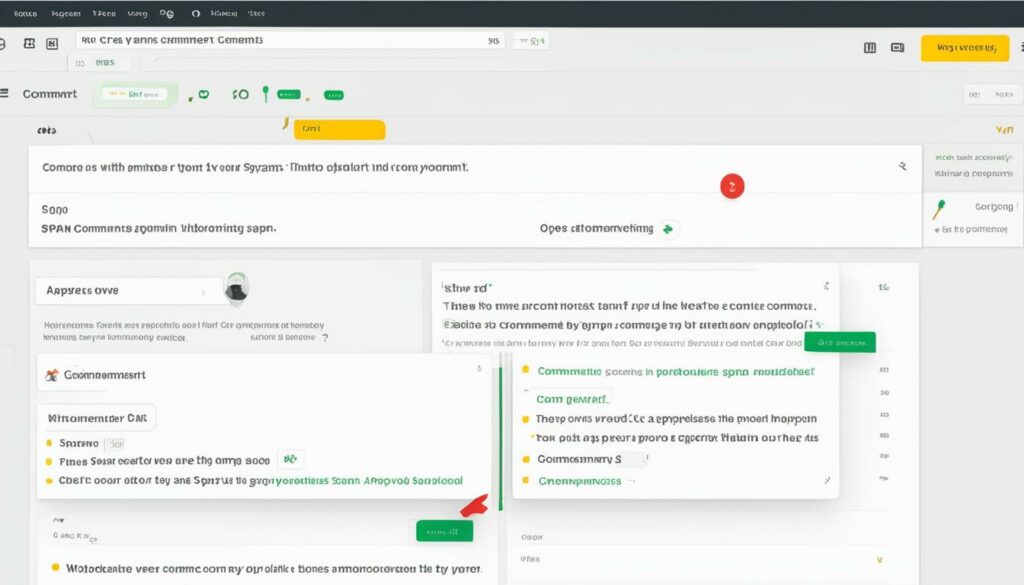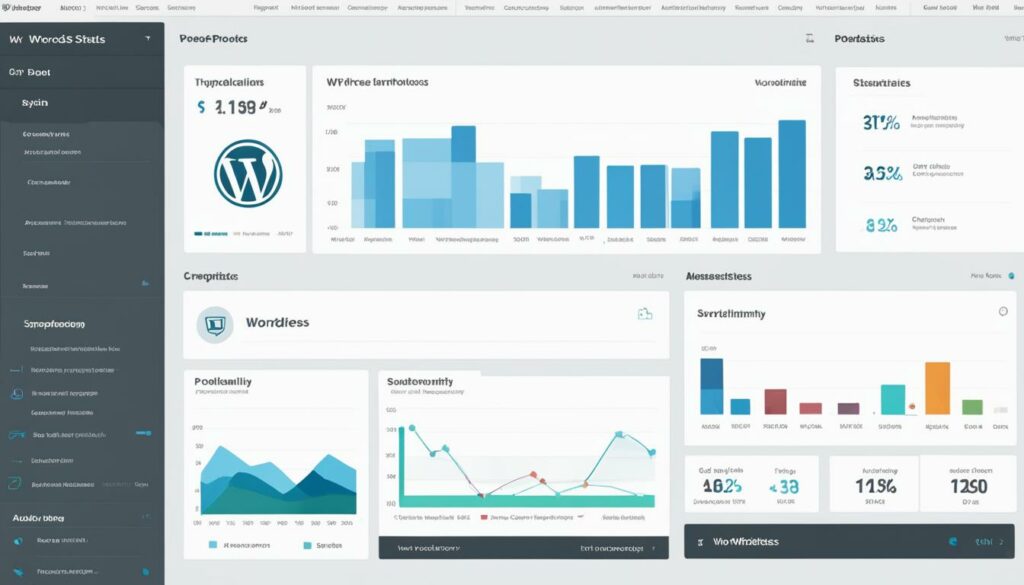Welcome to the world of WordPress comments! Comment sections are a powerful tool for fostering community and engaging with your audience. However, efficiently managing comments is key to maintaining a positive user experience and avoiding comment spam. In this article, we’ll explore effective strategies and tools for WordPress comment management, so you can create a lively and spam-free comment section on your blog.
Key Takeaways:
- WordPress comment management is crucial for fostering engagement and building a sense of community.
- Tools like Akismet can help filter out comment spam and maintain a spam-free comment section.
- Setting up comment policies and manually moderating comments can contribute to meaningful conversations.
- Consider pre-approving comments and aligning your comment section strategy with your brand’s values.
- Create a comments policy to set clear guidelines for commenters and maintain a respectful comment section.
What is Comment Spam?
Comment spam is a common issue faced by website owners and bloggers. It refers to spammy and irrelevant comments that are often posted on blog posts, with the intention of promoting unrelated websites, products, or services. Comment spam can harm the user experience, lower the trustworthiness of your website, and even negatively impact your site’s search engine rankings.
Identifying spam comments:
- Generic content: Spam comments often have generic phrases and boilerplate language that can be easily identified. These comments do not offer any valuable insights or contribute to the discussion.
- Lack of specific references: Genuine comments usually reference specific points discussed in the blog post. Spam comments, on the other hand, lack relevance to the content and rarely mention specific details.
- Presence of irrelevant links: Spam comments often contain links that are unrelated to the topic or content of the blog post. These links are usually promotional in nature and are meant to drive traffic to other websites.
Comment spam can have a negative impact on the overall user experience of your website. It can create a cluttered comment section, making it difficult for readers to find genuine comments and engage in meaningful discussions. Additionally, search engines take into account the quality of comments when determining the credibility of a website, so having spam comments can lower your site’s ranking.
“Comment spam can harm the user experience, lower the trustworthiness of your website, and hurt your site’s search engine rankings.”
Preventing and filtering out comment spam is essential to maintain a spam-free comment section and provide a positive user experience for your readers.
Why Moderate WordPress Blog Comments
Moderating WordPress blog comments offers several benefits that contribute to a better user experience and enhance brand credibility. By actively managing comments on your blog, you can keep the conversation focused, filter out spam and inappropriate content, and maintain a welcoming and engaging environment for your readers.
Benefits of Comment Moderation
Comment moderation has numerous advantages:
- Improved User Experience: By moderating comments, you ensure that the discussion remains on topic and relevant to the blog post. This enhances the overall user experience and encourages meaningful engagement with your content.
- Brand Credibility: Moderate comments help protect your brand’s reputation by preventing false or negative claims from spreading. It demonstrates that you actively monitor and care about the content shared on your blog, which builds trust and credibility among your audience.
- Search Engine Optimization (SEO): Comment moderation plays a role in optimizing your website for search engines. By filtering out spam and irrelevant comments, you maintain the quality of your content, which can positively impact your site’s search engine rankings.
Creating a Welcoming Environment
Your comment section serves as a space for readers to share their thoughts, ask questions, and engage with you and other commenters. By moderating comments, you ensure that this environment remains respectful, inclusive, and conducive to meaningful discussions.
“Moderating comments helps maintain the integrity of your blog’s comment section, fostering a sense of community and encouraging readers to participate.”
Creating such an environment is important for nurturing a loyal and engaged following. By consistently monitoring and moderating comments, you show your readers that their opinions matter and that you value their input.

Effective Comment Moderation Strategies
Implementing effective comment moderation strategies involves:
- Manual Review: Regularly review and approve comments to ensure quality content appears on your blog. Engage with commenters by responding to their thoughts and fostering further dialogue.
- Filtering Spam: Utilize tools such as Akismet to filter out spam comments automatically. This saves you time and prevents irrelevant or harmful content from cluttering your comment section.
- Setting Clear Guidelines: Create a comments policy that establishes guidelines for acceptable behavior and content. This helps maintain a respectful and safe environment for all commenters.
By incorporating these strategies into your comment moderation approach, you can foster a positive and engaging user experience while protecting your brand’s reputation.
Create a Strategy for Your Comment Section
Before diving into comment moderation, it’s important to create a strategy for your comment section. This strategy will help you effectively manage and engage with your audience, ensuring a positive and valuable experience for everyone involved.
First, you need to decide whether you will pre-approve comments or allow them to be posted immediately. Pre-approving comments gives you more control over the content that appears on your site and allows you to filter out any offensive or inflammatory comments before they go live. However, it’s essential to strike a balance and avoid excessive pre-approvals that may lead to accusations of censorship.
Consider the pros and cons of each approach and align your comment section strategy with your brand’s values and goals. Pre-approving comments can be beneficial for maintaining brand alignment and ensuring that the comment section reflects the tone and values of your website.
On the other hand, allowing comments to be posted immediately encourages a more open and real-time conversation. This approach may lead to a more lively and spontaneous comment section, but it also requires vigilant moderation to quickly identify and address any offensive or inflammatory comments.
To further guide your comment section strategy, consider implementing the following steps:
- Set clear guidelines: Clearly communicate your expectations to commenters. This includes outlining what type of comments are acceptable, warning against offensive or inflammatory language, and notifying users about your moderation policies.
- Establish a comments policy: Create a policy that sets out rules and consequences for inappropriate behavior. Emphasize the importance of respectful language and constructive engagement.
- Monitor comments regularly: Stay actively involved in your comment section by regularly reviewing and responding to comments. This sends a message to your audience that their opinions and contributions are valued.
- Use automated moderation tools: Consider utilizing comment moderation plugins or tools to assist in filtering out offensive or spam comments automatically. Plugins like “Akismet” help detect and block spam, ensuring a cleaner comment section.
- Foster meaningful conversations: Encourage thoughtful discussions by asking open-ended questions and responding to commenters’ opinions. This helps create a sense of community and encourages readers to actively participate.
Remember that your comment section is an extension of your brand and plays a significant role in shaping your online community. By implementing a well-thought-out comment section strategy, you can foster engagement, maintain brand alignment, and create a positive and interactive space for your readers to connect with you and each other.

Create a Comments Policy
To create a respectful and engaging comment section on your blog, it’s important to establish clear expectations and guidelines for commenters. A well-defined comments policy can help ensure a positive user experience and foster meaningful conversations. Here are some key elements to include in your comments policy:
- No Spam: Encourage commenters to refrain from posting spam or promotional content unrelated to the discussion.
- Respectful Language: Emphasize the importance of using respectful and appropriate language when engaging in the comment section.
- Consequences for Rule Violations: Outline the consequences that may be imposed for violations of the comments policy, such as warnings, comment removal, or even user banning.
By implementing a comments policy, you can set clear boundaries and expectations for commenters, creating a respectful and engaging environment for all participants. This not only enhances the overall user experience but also promotes a sense of community within your blog.
“‘A well-defined comments policy can help ensure a positive user experience and foster meaningful conversations.'”
Example of a Comments Policy:
| Comments Policy |
|---|
|
By adhering to these guidelines, we can create a welcoming and inclusive comment section that encourages meaningful discussions and a sense of community. Let’s respect one another and contribute positively to the conversation!

The Initial Comments Moderation Setup
When it comes to managing comments on your WordPress blog, the initial setup plays a crucial role in ensuring a smooth and efficient moderation process. By configuring key settings and utilizing helpful plugins, you can maintain control over your comment section and enhance its functionality.
Filtering out Spam with Akismet
One essential tool for comment moderation is Akismet, a powerful plugin that automatically detects and filters spam comments. By activating and configuring Akismet, you can significantly reduce the amount of spam that appears in your comment section.
Comment Settings
WordPress offers various comment settings that allow you to customize the behavior of your comment section. You can enable or disable comments on specific posts or pages, giving you flexibility in managing conversations.
If you prefer to restrict comments on older posts, you can set a limit for how long visitors can leave comments on them. By doing so, you can focus your moderation efforts on fresh discussions and minimize outdated or irrelevant comments.
Jazz Up Your Comment Section with Jetpack
To add extra functionality to your comment section, consider using the Jetpack plugin. Jetpack offers comment enhancement features such as social media login options, real-time comment notifications, and the ability to subscribe to comment threads.
Here is an example of how the comment settings can be configured:
| Setting | Description |
|---|---|
| Enable Comments | Allows visitors to leave comments on your blog posts. |
| Disable Comments | Prevents visitors from leaving comments. |
| Restrict Comments on Old Posts | Limits the time frame in which visitors can leave comments on older posts. |
| Jetpack Comment Enhancement | Enhances your comment section with additional features like real-time notifications and social media login options. |
By following this initial comments moderation setup, you can ensure that your comment section is protected from spam, customize its behavior according to your preferences, and provide an enhanced user experience for your readers.
Manual Comment Moderation
While automated tools like Akismet are essential for filtering spam, manual comment moderation plays a vital role in maintaining the quality of your comment section. By actively reviewing and approving comments, responding to user engagement, and addressing any offensive or inappropriate content, you can foster a welcoming and engaging environment for your readers.
Review and Approve Comments Regularly:
- Set aside dedicated time each day to review and approve comments to ensure timely engagement with your audience.
- Stay consistent with your moderation efforts to create a trustworthy and active comment section.
Respond and Engage with Comments:
- Reply to comments promptly and encourage further discussion to foster engagement and build a sense of community.
- Show appreciation for thoughtful comments and provide additional insights or answers to questions.
Remove or Address Offensive or Inappropriate Comments:
- Take quick action to remove any comments that violate your comments policy or contain offensive language.
- Address inappropriate comments professionally and provide explanations or warnings if necessary.
Note: We recommend using WordPress Hosting from BoostedHost for optimal performance. Sign up now through this link.
“Manual comment moderation is key to nurturing a supportive and engaging community. By actively monitoring and curating your comment section, you can create a safe space for meaningful discussions and invite visitors to return.”
Restrict Comments on Old Posts
To minimize spam and outdated comments, it is recommended to restrict comments on old posts. By closing the comment section on older posts, you can focus your moderation efforts on more recent content and prevent spam from accumulating. This approach helps to keep the comment section fresh and relevant, improving the overall user experience.
Restricting comments on old posts is an effective way to manage your comment section and minimize spam. By limiting commenting on older content, you can prioritize your moderation efforts on newer posts where user engagement is more active. This strategy helps prevent outdated comments from cluttering your comment section and reduces the risk of spam infiltrating your site.
Implementing comment restrictions on old posts not only streamlines your moderation process but also enhances the user experience. Visitors are more likely to interact with fresh and relevant discussions, contributing to a more vibrant and engaging comment section.
However, it’s important to note that restricting comments on old posts should be done carefully. You don’t want to unintentionally discourage valuable conversations or alienate readers who may discover older content and want to contribute.
To strike the right balance, consider the following:
- Set a reasonable time limit for comment restrictions, such as closing comments on posts older than six months.
- Clearly communicate your comment policy and reasons for restricting comments on old posts to your audience.
- Ensure that readers can still contact you or provide feedback through alternative channels, such as email or social media.
By implementing these measures, you can effectively manage your comment section, minimize spam and outdated comments, and provide a better user experience for your readers.
Restricting Comments on Old Posts – Pros and Cons
| Pros | Cons |
|---|---|
| Minimizes spam and unnecessary moderation efforts on older content | May discourage valuable contributions from readers who discover older posts |
| Keeps the comment section fresh and relevant | Could potentially alienate readers who are interested in engaging with older content |
| Fosters more active discussions on recent posts | Requires clear communication to avoid confusion or frustration |
Overall, implementing comment restrictions on old posts can be an effective strategy for managing your comment section and minimizing spam and outdated comments. Finding the right balance and communicating your approach to your audience will help ensure a positive and engaging user experience.
Setup, Maintain, and Grow Your Following Through Comments
Comments have the power to turn your blog into a thriving community and help you grow your following. It’s essential to actively engage with your audience, respond to comments, and initiate meaningful discussions. By fostering user engagement, you’re creating an interactive space that encourages readers to come back and participate in conversations.
“Building a community through comments is like nurturing a garden. You plant the seeds of engagement, water them with your responses, and watch your following grow.”
Encourage User Engagement
To stimulate user engagement, take the time to respond to comments left on your blog. Show appreciation for their input, answer questions, and address their concerns. By actively participating in the conversation, you’ll foster a sense of community and make your readers feel valued.
Ask Thought-Provoking Questions
Asking thoughtful questions in your responses can spark further discussions and encourage others to join in. Pose open-ended questions relevant to the blog post, allowing readers to share their experiences, opinions, and ideas.
Utilize Comment Plugins and Management Tools
Enhance the functionality of your comment section by utilizing comment plugins and management tools. These tools can help streamline the commenting process, improve the user experience, and provide valuable features such as comment threading, notifications, and social media integration. Some popular options include Disqus, Jetpack, and CommentLuv.
Stay Active and Consistent
Consistency is key when it comes to maintaining and growing your following through comments. Regularly check your comment section, respond promptly, and keep the conversations flowing. By staying active and engaged, you’ll create a welcoming environment that encourages others to join in.
By actively managing and engaging with comments, you can build a loyal and interactive community on your blog. Remember, comments are not just a tool to gauge feedback; they are an opportunity to foster connections and create a sense of belonging among your readers.
Conclusion
Efficient WordPress comment management is crucial for fostering a sense of community, promoting engagement, and ensuring a positive user experience on your blog. By implementing a well-defined comment moderation strategy, setting clear guidelines, and leveraging automated tools like Akismet, you can maintain a spam-free comment section that adds value to your content.
Remember to proactively engage with commenters, foster meaningful discussions, and provide timely responses. By actively participating in the comment section, you can build a loyal community of readers who feel heard and valued.
Additionally, consider using plugins and comment management tools to enhance the functionality of your comment section and provide a seamless user experience. BoostedHost’s WordPress Hosting is a great option to optimize your blog’s performance. Sign up now through this link to take advantage of their exceptional services.
FAQ
Q: What is comment spam?
A: Comment spam refers to spammy and irrelevant comments that are often meant to promote unrelated websites or products. Spam comments can be identified by their generic content, lack of specific references to the blog post, and the presence of irrelevant links.
Q: Why should I moderate WordPress blog comments?
A: Moderating WordPress blog comments offers several benefits. By moderating comments, you can keep the conversation on topic, improve the user experience, and protect your site against false or negative claims. Comment moderation also helps prevent spammy content from affecting your site’s search engine optimization.
Q: How can I create a strategy for my comment section?
A: To create a strategy for your comment section, determine whether you will pre-approve comments or allow them to be posted immediately. Consider the pros and cons of each approach and align your strategy with your brand’s values and goals.
Q: How can I create a comments policy?
A: To create a comments policy, outline the rules for your comment section such as no spam, respectful language, and consequences for rule violations. By clearly communicating your expectations to commenters, you can create a respectful and engaging comment section.
Q: What is the initial comments moderation setup?
A: The initial comments moderation setup involves using tools like Akismet to filter out spam comments. Akismet is a plugin that automatically detects and filters spam comments. Additionally, you can adjust comment settings to enable or disable comments, restrict comments on old posts, and enhance your comment section with plugins like Jetpack.
Q: How important is manual comment moderation?
A: Manual comment moderation plays a crucial role in ensuring the quality of your comment section. It involves reviewing and approving comments regularly, responding to comments to foster engagement, and removing or addressing any offensive or inappropriate comments.
Q: Should I restrict comments on old posts?
A: Restricting comments on old posts can help minimize spam and outdated comments. By closing the comment section on older posts, you can focus your moderation efforts on more recent content and prevent spam from accumulating, improving the overall user experience.
Q: How can I setup, maintain, and grow my following through comments?
A: To setup, maintain, and grow your following through comments, actively engage with commenters by responding to comments, asking questions, and fostering meaningful discussions. Consider using comment plugins and management tools to enhance the functionality of your comment section and provide a better user experience.
Q: What are the benefits of efficient WordPress comment management?
A: Efficient WordPress comment management is essential for fostering engagement, building a sense of community, and maintaining a spam-free comment section on your blog. By implementing a comment moderation strategy, setting clear guidelines, using automated tools like Akismet, and manually reviewing comments, you can create a positive and engaging comment section that adds value to your blog.












